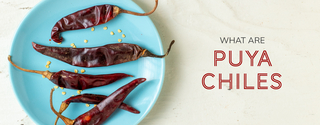What Are Puya Chiles
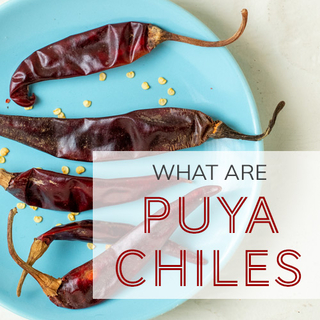
What Are Puya Chiles
Puya chiles belong to the botanical family Capsicum annuum, and they are called by the same name, whether fresh or dried. Puya are also called chile puya, chile pulla, or puya peppers. This is a medium-heat Mexican chile with a fun, fruity flavor and a playful pop of heat. Puya peppers are elongated; they are less than 1 inch wide and 3 to 4 inches long and taper to a point.
Table of Contents
What Does Puya Chile Taste Like?
What Are Puya Peppers Used For?
How Long Do Puya Dried Chiles Last?
All About Puya Chile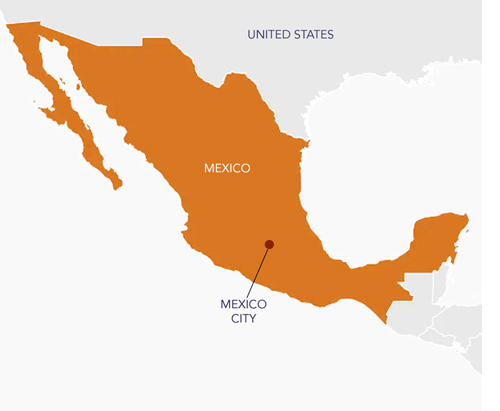
Puya chiles, pronounced “PU-yah”, means “prod” or “goad”, and is probably referring to the sharp, spicy bite these peppers deliver. They’re a little hotter than a jalapeno, and their thin flesh is perfect for rehydrating and mashing into sauces or salsa. This is a favorite chile used in traditional Mexican kitchens.
This pepper has been cultivated in Mexico’s Central Valley, the area surrounding Mexico City, since ancient times. It is also abundant in Michoacan and Jalisco, two states which abut the Mexico City region. UNESCO has recognized Michoacan for its preservation of traditional Mexican recipes and cooking techniques, including the authentic Michoacan-style pulla (Puya) salsa, a ubiquitous table salsa found throughout central and western Mexico.
If you’re taking the journey to learn about Mexican chile peppers, and have heard of Puya chiles and want to make sure they’re right for you, we are here to help.
The staff at Spices, Inc. has been sourcing, processing, and selling Mexican dried chiles for over a decade. Our chiles can be found in Mexican restaurants, with small-batch hot sauce manufacturers, and steeping in micro-breweries.
In short, we know Puya chiles. This article covers the questions you may have regarding the Puya pepper. We discuss what they are and how to prepare them for use. There’s information on proper storage and suggestions on how to use them. We advise where to find them and what to look for when buying. We also help point out the differences between Puya chiles and other closely related peppers.
Is Chile Puya Same as Guajillo?
Puya and Guajillo chiles look and taste somewhat similar but are not the same. They both share a light, fruity flavor profile. However, Puya peppers are slightly smaller and consistently hotter than Guajillos. The Puya’s lowest heat level is a Guajillo’s highest heat, and the Puya can be fully twice as hot as the Guajillo.
Where Are Puya Chiles From?
Puya peppers are native to Mexico’s Central Valley, a large, highlands plateau ringed by volcanoes and mountains. It is the current home of Mexico City but has been home to ancient Mexicans for more than 12,000 years.
| Ingredients | Puya chiles |
| Also Called | Chile puya, chile pulla, or puya peppers |
| Recommended Uses | Use in breakfast burritos, casseroles, chutneys, cooked vegetables, dips, enchiladas, pizza, salsas, sauces, soups, and stews |
| Flavor Profile | A light, fruity flavor profile, with licorice and cherry undertones reminiscent of wild berries |
| Scoville Heat Units | 5,000-8,000 SHU |
| Botanical Name | Capsicum annuum |
| Cuisine | Mexican |
| How To Store | Airtight container in a cool, dark place |
| Shelf Life | 1-2 Years |
| Country of Origin | Mexico |
What Does Puya Chile Taste Like?
Puya chiles are fruity and playful, with notes of cherry and licorice that give them depth.
How Hot Are They?
Puya peppers measure 5,000-10,000 Scoville Heat Units. This makes them a little bit hotter than a jalapeno.
What Are Puya Peppers Used For?
Puyas are popular chiles in central Mexican cuisine. They are used to flavor chicken, fish, pork, or veal.
We love them in a pungent, smoky sauce to pour over Chilaquiles, but their fruity flavor would be terrific in any fruit salsa you could imagine. They bring spunky flavor to breakfast burritos, casseroles, chutneys, cooked vegetables, dips, enchiladas, pizza, salsas, sauces, soups, and stews.

How to Deseed
To deseed Puya peppers, pull the caps off or slice them across the top of the pepper and pour out the seeds.
Once they are deseeded, put them in a dry pan and toast them over medium-high heat for 20-30 seconds per side. The peppers will start to look toasty, and their fragrance will emerge. You can press them into the pan with a spatula to ensure even toasting. Remove them from heat. Once they are toasted, they are ready to be rehydrated or ground.

How to Rehydrate
Puya chiles have thin flesh, so they don’t require much effort to rehydrate. Once you have finished toasting them, pour boiling water over them until they’re all covered. Let the Puyas sit for 10-15 minutes. Drain the water. These chiles are now ready to be mashed or turned into paste.
The skins may feel tough even after soaking, but they mash easily and don’t create clumps or odd textures.
We don’t recommend saving the soaking water for Puya chiles. It is bitter and unpleasant.
How to Make Puya Chile Powder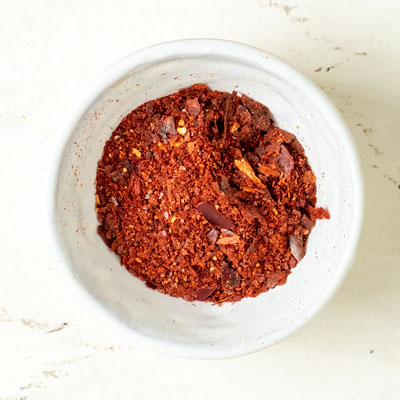
Once toasting is complete, let the chiles cool enough so you can comfortably handle them. Tear them into pieces and toss them in a mortar and pestle or electric spice grinder. Grind them into flakes or powder. You can use them right away or store them in an airtight container away from light and heat.
Can You Buy Ground Puya Chiles?
You can buy ground Puya chiles from some vendors. Make sure you’re purchasing from a supplier you can trust. Because of the thin skin of the Puya chile, it’s easy for volatile oils to dissipate once they’re ground, so you should be able to guarantee that they are freshly ground.
Because of this, we recommend buying whole Puya peppers and grinding them yourself.
How Long Do Puya Dried Chiles Last?
Dried Puya peppers can be successfully stored in most pantries for 1-2 years, as long as they’re properly cared for.
Chiles should be kept from direct sunlight, heat, and moisture, and the container should be airtight. Ideal storage situations mean they are exposed to no direct sunlight. The humidity should always be low, and the temperature should not dip below 60°F, nor should it go above 72°F.
Ideal conditions would allow you to store chiles for 2-3 years. Since this level of climate control is not practical for most kitchens, we think you should expect 1-2 years of successful storage as a standard.
In pantries that shield peppers from heat and humidity, your stored Puya chiles should feel dry but retain pliability. They should also have a deep brownish-red and a light, peppery aroma. If your Puyas lack aroma, look grey or ashy, break easily, or show signs of mold, you should throw them out and buy fresh chiles.
As a general rule, chiles should not be stored near a stove. The cooking process can change the temperature in the air around a stove and raise the heat in a storage container. This can cause peppers to sweat out the little moisture retained in the cell walls and alter the humidity in the storage container.
Air-tight containers won’t allow this moisture to evaporate out so that it will settle back on the surface of the peppers. This can initiate mold growth.
Puya Chile Substitution
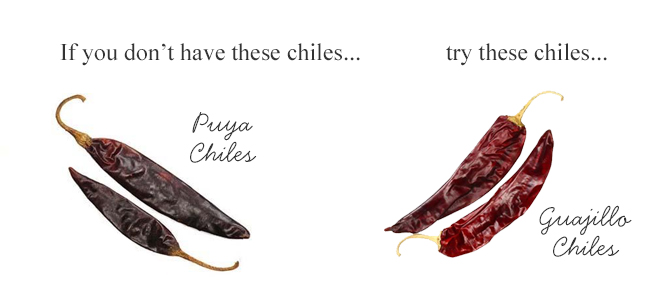
If you do not have Puya chiles, Guajillo chiles are an acceptable substitute. Guajillo chiles have a similar fruity flavor but are not as hot. You may want to supplement the heat with a pinch of Cayenne Chile Powder.
Can I Use Chile Puya Instead of Guajillo Chiles?
You can use chile Puya as a substitute for Guajillo peppers. Just bear in mind that Puya chiles are hotter than Guajilllos, so you may want to use less Puya. You could add a little Ancho Chile Powder to the mix if you wanted to boost the fruity flavor without adding heat.
What to Look for When Buying Puya Chiles
If you’re looking at a batch of Puya chiles, you should expect to find most of them intact. They have thin skins, so it’s practical to expect that a few Puyas may sustain some damage during shipment, no matter which vendor you’re shopping at. Still, it's preferable that the majority of your chiles are unbroken. They have thin skin and flesh and their volatile oils can quickly evaporate once the skin is broken, which could compromise flavor. The skin should have a rich, maroon color and give off a light, fruit-and-pepper scent.
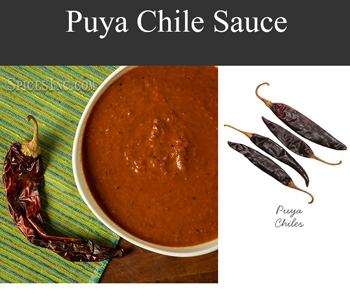
|
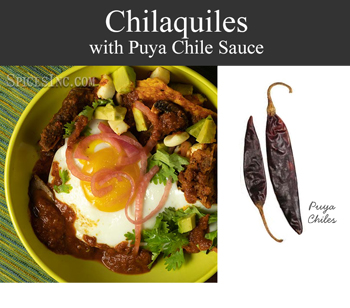
|
Where to Buy Puya Chiles
Puya chiles can be found in several places. Look for them in Mexican markets, grocery stores, and online retailers. Each one of these shopping venues offers positives and negatives.
Smaller Mexican markets often enjoy the benefits of having staff that knows their chiles, which is a decided plus. However, these shops tend to be small and may not have much sway when they buy peppers from wholesalers. They often pay higher prices, which get passed along to the consumer.
They also usually don’t turn over their product at a high rate, and if their inventory moves slower, the less-fresh product goes out the door, resulting in less flavorful chiles.
Buyers for national grocery store chains can often negotiate better purchasing prices behind the scenes. This translates to lower prices for the consumers.
However, bulk buyers often focus on bottom-line costs, not top-notch quality. Also, workers throughout the distribution process are not necessarily specialists in chile peppers, so they may not realize the difference between chiles of a similar appearance. This can, and occasionally does, result in incorrect products getting passed along to the consumer.
Big-box vendors make one-stop shopping easy; you can get chiles along with some new T-shirts, all from the comfort of the couch. They ship to your door and may offer free shipping depending on their policies. However, these companies are often simply fulfillment centers for smaller businesses and provide no oversight for the quality of chiles shipped to your door. The return process for faulty chile peppers can be difficult to initiate.
If you shop at an online specialty retailer, you can usually find a good selection of chiles, and they can explain the differences between a Puya and a Guajillo.
Shops like this thrive when selling Puya peppers because their reputation matters. There are usually procedures that ensure order fulfillment is done promptly and accurately. Staff is generally well-trained from order-taking to picking and packing, so they can meet their customers’ needs and send out high-quality peppers.
Puya chiles have a delicious, bright flavor and just enough of a spicy kick to make any dish sizzle. They’re easy to use, whether you’re looking to rehydrate them or grind them into powder. It’s a favorite in Mexican kitchens, and we’d love to see this great-tasting pepper become a favorite in the US.
Mexico has changed the world’s cuisine thanks to the way chiles from there have been traded around the globe. We invite you to read more about Mexico’s dried chiles and their many flavors and spice up your kitchen, too.

